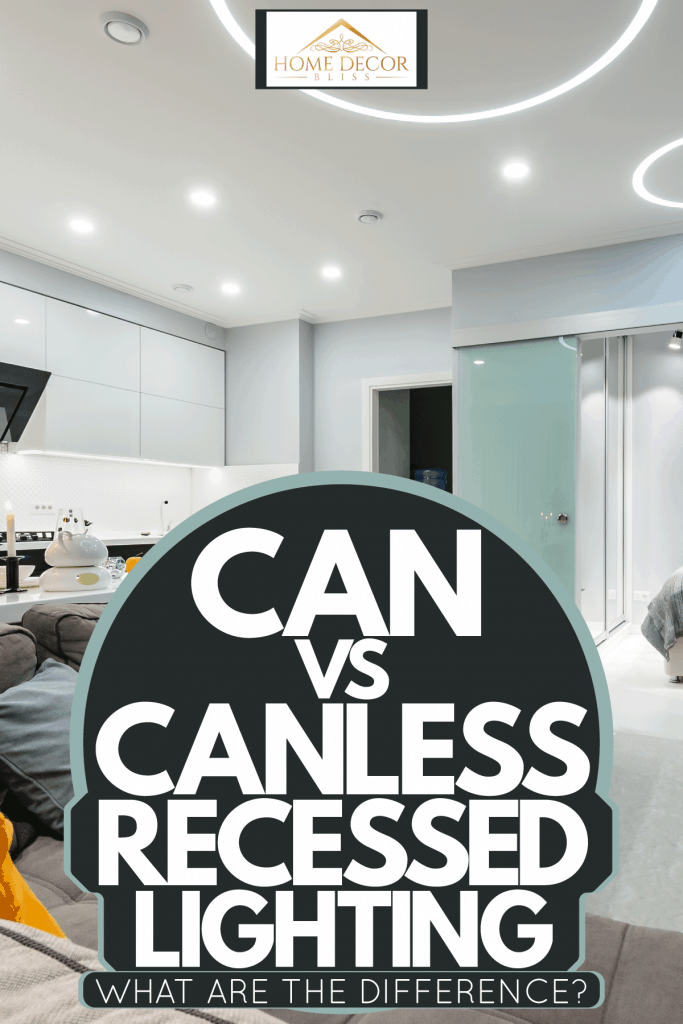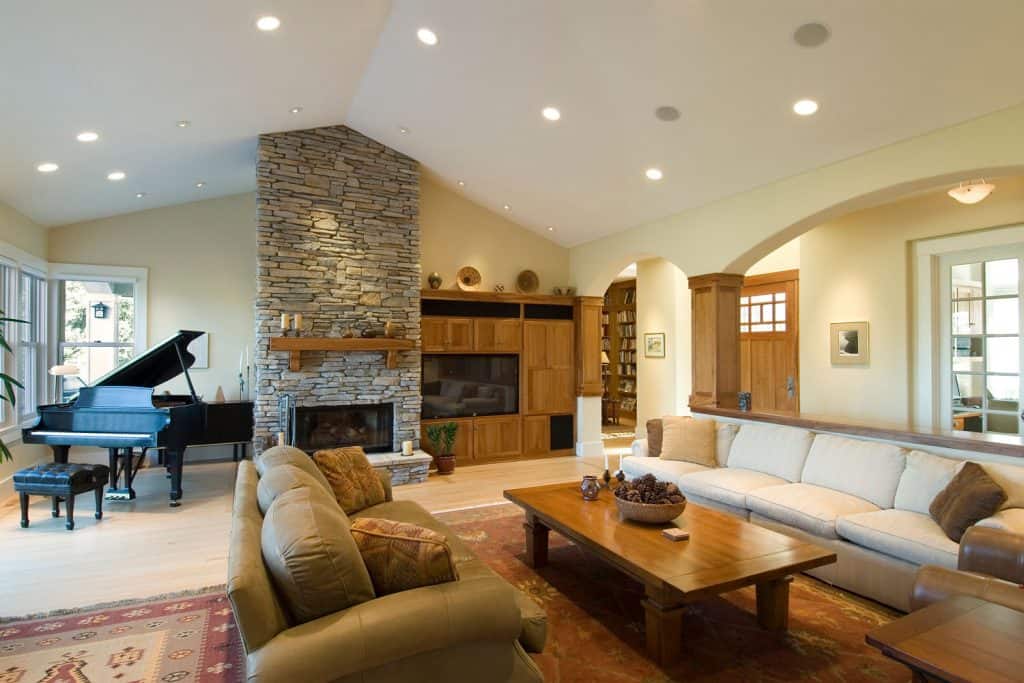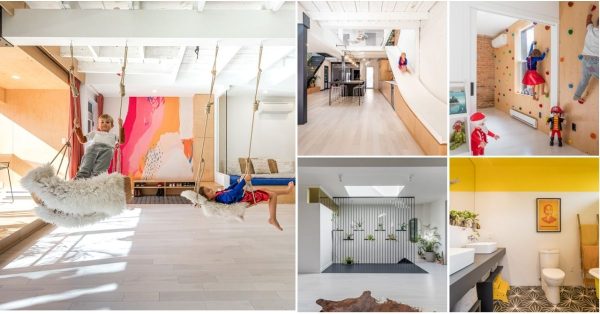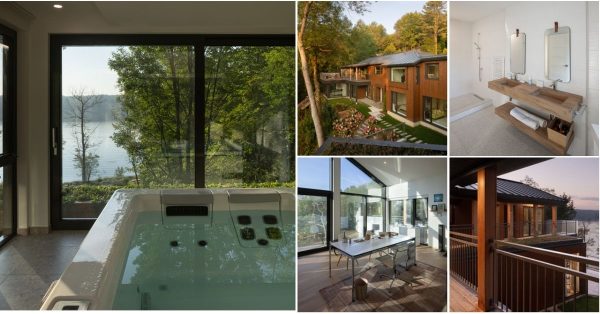When deciding what lighting options to use in your house, recessed lighting is a great option. Recessed light fixtures don't take up space and offer a lot of options. One of the most basic choices is whether or not to get a can or canless fixture. We have researched the differences between the two to help you choose the best option for your style.
Can fixtures consist of a light contained in a can-shaped housing that is put entirely into your ceiling, wall, or floor. They usually come with hangers and rods for mounting. The shape of a can protects the light bulb, and they often have an electrical box in the top of the housing.
On the other hand, canless lights are not contained in a can. Instead, they are a single unit with a thin housing connected directly to your electrical wires. Most canless lights are thin disks with LED lights attached to them. Because of the way they are connected to your wiring, they don't require an electrical box.
As you might have guessed, their different shapes give them each their own advantages and disadvantages. This article is going to go into depth about these pros and cons.

All About Cans Lights
Can lights are usually between 3 to 6 inches in size. If you have low ceilings, can lights are probably the best option because they will blend with the ceiling. Plus, can lights have a lot more trim options than canless lights do.
When you install can lights, the installation tends to be largely standardized between units. This means that all can lights are installed in a very similar way. As a result, once you've learned how to install them, you can install most of the can lights.

We may include affiliate links and curated AI content to highlight top design styles.
However, can lights require complete access to your ceiling. They are much easier to install while building a home. This is because they are easier to install before the drywall has been placed.
One of the biggest downsides to a can light is that it lowers your house's insulation value. It also has limits to where it can be placed, determined by the orientation of joists and trusses in your home.
Can lights allow you to easily replace a light bulb if it is burnt out. However, because can lights take light bulbs instead of LEDs, they tend not to be as bright. On the other hand, because can lights have a can-shaped fixture, they direct the light better than canless ones do.
Canless Lights

Most canless lights have built-in LED lights. This means that when they quit working, you have to replace the whole fixture. However, unlike light bulbs, LEDs don't burn out.
They dim until they get too dim to work. The lifespan of an LED bulb is up to 50,000 hours. This is about 50 times longer than an incandescent bulb. Also, LEDs tend to be brighter than incandescent light bulbs but require more of them to light a room.
Since most canless lights utilize LEDs, they tend to be more energy-efficient than can lights. This is because the lack of a fixture means there aren't holes for heat and air conditioning to escape through, and LED lights are more energy-efficient than other bulbs.
When installing a canless light, there isn't an installation standard. This means that each one might have its own special way to install it. However, they tend to take less time and are easier to install than can lights.
Unlike their counterparts, canless lights can be installed without worrying about the joists. This is because the way they are installed allows them to be positioned across trusses and joists.
Because the housing on canless lights is smaller, there are fewer trim options available for it. However, they tend to be slightly cheaper than can lights because they don't have as much of a fixture. They range from about $40 to $160, while can lights cost about $60 to $240.
What Is The Most Common Size For Recessed Lights?

The most common sizes in a residential home are 4 inches to 7 inches. Out of those sites, the 6 inches fixture is the most popular. As a result of its popularity, you will have an easier time finding lots of styles for a 6-inch fixture.
To decide what size you need, consider the area you want lit. How far away is the ceiling from that area, and how much do you want the area lit up? Keep in mind recessed lighting is not as bright as standard lighting.
For example, if you have a ceiling that is 8 feet, a 4 inch light will illuminate the kitchen countertop nicely. However, if you have an 8-foot ceiling and want to light something a bit lower than a countertop, like a kitchen table, use a 6-inch fixture. For someone with a 10-foot ceiling, you may want to use a bunch of 4-inch fixtures, as that will spread the light out evenly.
Where Should I Put Recessed Lighting?
Recessed lighting isn't as bright as a traditional light fixture. For that reason, there is a formula for figuring out exactly where to place your lights. It is calculated based on what you are aiming to light.
This formula is that the distance between lights should always be double what it is at the ends. You will also need to know the number of lights, the layout, and the room or surface dimensions.
If you are using recessed lighting as an accent light, you will want the light to be at 30 degrees from the ceiling to reduce glare. There is also a formula for calculating this.
What Size Bulb For Can Lights?

There are several different sizes for can lights. Your fixture will tell you what specific one you should use. However, the most common sizes are BR30 and BR40 LED lights.
The "BR" part of the bulb's name is the shape. It stands for a bulged reflector. The number part refers to the size of the bulb in 1/8 inches. For instance, BR30s are 30/8 of an inch, or just under 4 inches, across.
For low ceilings, BR30s will be sufficient. However, if you want more light, BR40s tend to come in higher wattages, making them brighter.
Most cans are between 4 inches and 6 inches. If you have a 4-inch can, BR40 will be too big. However, if you have a 6-inch can, BR30 will be too small.
If you are looking for BR30 bulbs, click here to check out these Sylvania 65 W bulbs on Amazon!
Are Recessed Lights A Fire Hazard?

If you have IC-rated lights, they are most likely not a fire hazard. However, if it is improperly installed or non-IC rated, there is a fire risk.
This is because, just like any form of lighting, it can overheat. If the lights go above 194 degrees Fahrenheit, you might have a fire on your hand.
Fires can result from faulty wiring and improper installation. To prevent this risk, be sure that if you have a non-IC rated unit, it does not come into contact with any insulation. Before installing your lights, have a professional check your wiring to ensure it is suitable for recessed lighting.
Do Recessed Lights Die?

Just like any type of lighting, over time, recessed lights will break down or stop working. Sometimes this is just due to a burnt-out bulb. It can also be caused by old age, a sagging trim, over insulation, or a blown light socket.
If you use LED bulbs in your fixtures, you can get up to 5 and a half years of life out of your lights(which is about 50,000 hours). However, if you use incandescent bulbs, you will get significantly less time, around 1,000 hours. Fluorescent bulbs will get you about 10,000 hours of use before needing to be changed.
Final Thoughts
So, now you know the main differences between can and canless recessed lighting. You also know some of the advantages and disadvantages of both and how to calculate where to place your lights. Armed with this knowledge, you are more than ready to go pick out your lights!
However, before you go, check out the links below to read some more interesting articles on this blog.
Can You Put Recessed Lighting In A Garage?
8 Of The Best Lighting Options For A Sloped Ceiling
FAQs
What is the difference between a can light and a recessed light?
A can light, a recessed downlight, is a type of light fixture installed into the ceiling. It sits flush with the ceiling and directs light downward. A recessed light is a type of light fixture installed into the ceiling and has a trim extending slightly below the ceiling line. This type of light fixture can direct light in multiple directions.
What are can lights used for?
Can or recessed lights are most often used to provide general or task lighting in a room. They are typically installed in the ceiling and can illuminate various areas, from kitchens and bathrooms to living rooms.
What does a can light look like?
A can light is a type of recessed light fixture that is mounted in the ceiling. It typically has a metal housing, or “can,” surrounding the light bulb. The can is usually painted white to help reflect the light from the bulb and create a soft, even glow.
How do canned lights work?
Canned or recessed lights are installed in the ceiling and work by reflecting light off the surrounding walls and ceiling. The light is directed downward and outward, providing a more even distribution in the room. The recessed light's can, or housing, is sealed to protect it from heat and moisture. The light bulb is mounted in the can, and the housing is airtight to prevent air from entering, which can cause the bulb to overheat. A trim ring covers the can's opening, which helps reduce glare and provides a neat and finished look.





You missed an important point. When a canless light fixture burns out (in my case it was several months after install), the replacement fixture may not be a perfect match to the other fixtures. I purchased the same exact model and brightness description however it was noticeably different! I happened to have one extra fixture and used it. When another burns out I may have to replace all of my fixtures.
buying a replacement fixture
I’ve never had an LED last longer than an incandescent light so the problem of replacing the entire fixture will occur more frequently than suggested (5 years).
You don’t have to use an incandescent bulb in canned lighting fixtures. There are plenty of options for using LED that replace incandescent bulbs in canned fixtures which I’ve done in my home and it works great.